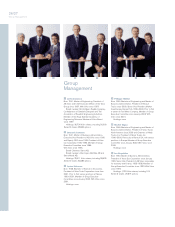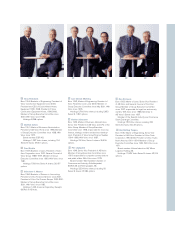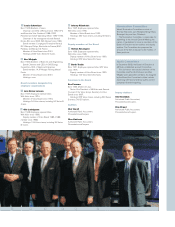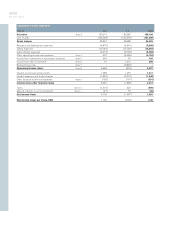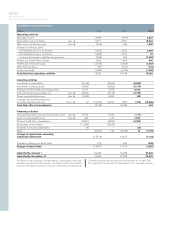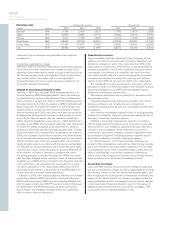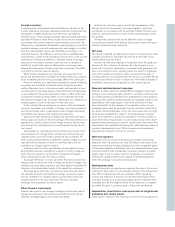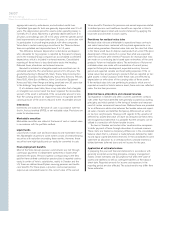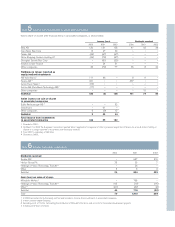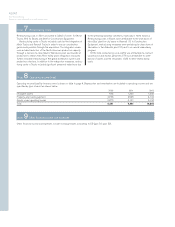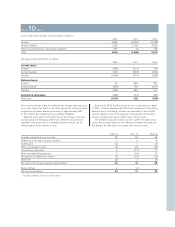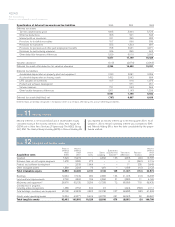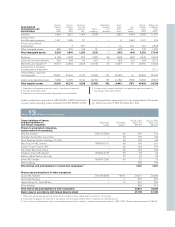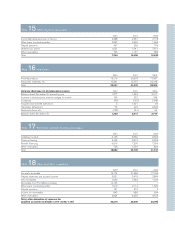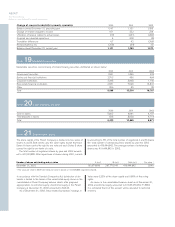Volvo 2002 Annual Report Download - page 38
Download and view the complete annual report
Please find page 38 of the 2002 Volvo annual report below. You can navigate through the pages in the report by either clicking on the pages listed below, or by using the keyword search tool below to find specific information within the annual report.
36/37
The Volvo Group
Notes to consolidated financial statements
appropriate cases by write-downs, and estimated useful lives.
Capitalized type-specific tools are generally depreciated over 2 to 8
years. The depreciation period for assets under operating leases is
normally 3 to 5 years. Machinery is generally depreciated over 5 to
20 years, and buildings over 25 to 50 years, while the greater part of
land improvements are depreciated over 20 years. In connection with
its participation in aircraft engine projects with other companies,
Volvo Aero in certain cases pays an entrance fee. These entrance
fees are capitalized and depreciated over 5 to 10 years.
The difference between depreciation noted above and depreci-
ation allowable for tax purposes is reported by the parent company
and in the individual Group companies as accumulated accelerated
depreciation, which is included in untaxed reserves. Consolidated
reporting of these items is described below under the heading
Deferred taxes, allocations and untaxed reserves.
Goodwill is included in intangible assets and amortized over its
estimated useful life. The amortization period is 5 to 20 years. The
goodwill pertaining to Renault V.I., Mack Trucks, Volvo Construction
Equipment, Champion Road Machinery, Volvo Aero Services, Prévost,
Nova BUS, Volvo Bus de Mexico, Volvo Construction Equipment
Korea and Volvo Aero Norge are being amortized over 20 years due
to the holdings’ long-term and strategic importance.
If, at a balance sheet date, there is any indication that a tangible
or intangible non-current asset has been impaired, the recoverable
amount of the asset is estimated. If the recoverable amount is less
than the carrying amount, an impairment loss is recognized and the
carrying amount of the asset is reduced to the recoverable amount.
Inventories
Inventories are stated at the lower of cost, in accordance with the
first-in, first-out method (FIFO), or net realizable value. Provisions are
made for obsolescence.
Marketable securities
Marketable securities are stated at the lower of cost or market value
in accordance with the portfolio method.
Liquid funds
Liquid funds include cash and bank balances and marketable securi-
ties. Marketable securities to some extent consist of interest-bearing
securities with maturities exceeding three months. However, these
securities have high liquidity and can easily be converted to cash.
Post-employment benefits
Most of the Volvo Group’s pension commitments are met through
continuous payments to independent authorities or bodies that
administer the plans. Pension expense corresponding to the fees
paid for these defined-contribution pension plans is reported continu-
ously. In certain of Volvo’s subsidiaries, mainly in Sweden and the
US, there are defined benefit plans covering pensions and health-
care benefits. For these plans, a provision and annual pension
expense are calculated based on the current value of the earned
future benefits. Provisions for pensions and annual expenses related
to defined pension and healthcare benefits are reported in Volvo’s
consolidated balance sheet and income statement by applying the
local rules and directives in each country.
Provisions for residual value risks
Residual value risks are attributable to operational lease contracts
and sales transactions combined with buy-back agreements or re-
sidual value guarantees. Residual value risks are the risks that Volvo
in the future would have to dispose used products at a loss if the price
development of these products is worse than what was expected
when the contracts were entered. Provisions for residual value risks
are made on a continuing basis based upon estimations of the used
products’ future net realizable values. The estimations of future net
realizable values are made with consideration of current prices,
expected future price development, expected inventory turnover
period and expected variable and fixed selling expenses. If the re-
sidual value risks are pertaining to products that are reported as tan-
gible assets in Volvo’s balance sheet, these risks are reflected by
depreciation or write-down of the carrying value of these assets.
If the residual value risks are pertaining to products which are not
reported as assets in Volvo’s balance sheet, these risks are reflected
under the line item provisions.
Deferred taxes, allocations and untaxed reserves
Tax legislation in Sweden and other countries sometimes contains
rules other than those identified with generally accepted accounting
principles, and which pertain to the timing of taxation and measure-
ment of certain commercial transactions. Deferred taxes are provided
for on differences which arise between the taxable value and report-
ed value of assets and liabilities (temporary differences) as well as
on tax-loss carryforwards. However, with regards to the valuation of
deferred tax assets (the value of future tax deductions), these items
are recognized provided that it is probable that the amounts can be
utilized in connection with future taxable income.
Tax laws in Sweden and certain other countries allow companies
to defer payment of taxes through allocations to untaxed reserves.
These items are treated as temporary differences in the consolidated
balance sheet, that is, a division is made between deferred tax liabil-
ity and equity capital (restricted reserves). In the consolidated income
statement an allocation to, or withdrawal from, untaxed reserves is
divided between deferred taxes and net income for the year.
Application of estimated values
In preparing the year-end financial statements in accordance with
generally accepted accounting principles, company management
makes certain estimates and assumptions that affect the value of
assets and liabilities as well as contingent liabilities at the balance
sheet date. Reported amounts for income and expenses in the
reporting period are also affected. The actual results may differ from
these estimates.


